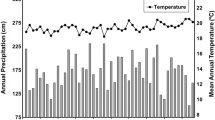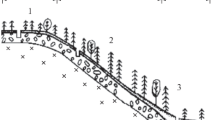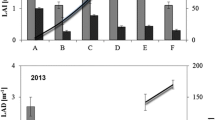Abstract
Lignan concentrations in Norway spruce (Picea abies [L.] Karst.) knotwood were studied in two long-term nitrogen fertilised experimental sites: a boreal site (66°5′N, 27°07′E) close to the Arctic tree line in northern Finland and a boreal site (61°10′N, 26°03′E) in southern Finland. Altogether 20 mature trees, representing five different size classes, were felled in the autumn 2002 and knots of the largest and smallest diameter in each whorl at the height of 4 m were analysed. Within-stem variation of knotwood lignans was studied at the 4 m intervals from stump height to the top from five control trees in the southern site. The following knotwood lignans were identified with GC-MS: hydroxymatairesinol (two isomers), secoisolariciresinol, α-conidendrin, α-conidendric acid, isohydroxymatairesinol, lariciresinol, lignan A, matairesinol, nortrachelogenin, todolactol A and isoliovil. The predominant lignan in Norway spruce knotwood was hydroxymatairesinol comprising approximately 77% of the total concentration of lignans. In mature trees in the southern site, the lignan concentrations were highest close to the starting point of the living branches. In the northern site, the total concentration of knotwood lignans was significantly higher (approximately 14% of the dry mass) than in the southern site (approximately 5.4% of the dry mass). In the northern site in control trees, a negative linear correlation was detected between branch diameter and hydroxymatairesinol concentration, but the similar correlation was not detected in fertilised trees or in the trees of the southern site. The possible reasons for higher hydroxymatairesinol concentrations in the northern knots were discussed.




Similar content being viewed by others
References
Ahotupa M, Eriksson J, Kangas L, Unkila M, Komi J, Perala M, Korte H (2003) Method for inhibiting overactivity of phagocytes and lymphocytes in an individual. US pat Appl No US 2003/0100514 A1
Cronin G, Lodge DM (2003) Effects of light and nutrient availability on the growth, allocation, carbon/nitrogen balance, phenolic chemistry, and resistance to herbivory of two freshwater macrophytes. Oecologia 137:32–41. doi:10.1007/s00442-003-1315-3
Eklund PC, Sillanpää R, Sjöholm R (2002) Synthetic transformation of hydroxymatairesinol from Norway spruce (Picea abies) to 7-hydroxyseco- isolariciresinol, (+)-lariciresinol and (+)-cyclolariciresinol. J Chem Soc Perkin Trans I 16:1906–1910. doi:10.1039/b202493d
Eklund P, Lindholm A, Mikkola J-P, Smeds A, Lehtilä R, Sjöholm R (2003) Synthesis of (–)-matairesinol, (–)-enterolactone, (–)-enterodiol from the natural lignan hydroxymatairesinol. Org Lett 5:491–493. doi:10.1021/ol0273598
Eklund PC, Willför S, Smeds A, Holmbom BR, Sjöholm RE (2004) A new lariciresinol-type butyrolactone lignan derived from hydroxymatairesinol and its identification in spruce wood. J Nat Prod 67:927–931. doi: 10.1021/np0340706
Eklund PC, Långvik OK, Wärnå JP, Salmi TO, Willför SM, Sjöholm RE (2005) Chemical studies on antioxidant mechanisms and free radical scavenging properties of lignans. Org Biomol Chem 3:3336–3347. doi:10.1039/b506739a
Ekman R (1976) Analysis of lignans in Norway spruce by combined gas chromatography-mass spectrometry. Holzforschung 30:79–85
Ekman R, Holmbom B (1989) Analysis by gas chromatography of the wood extractives in pulp and water samples from mechanical pulping of spruce. Nord Pulp Pap Res J 4:16–24
Ekman R, Peltonen C, Hirvonen P, Pensar G, von Weissenberg K (1979) Distribution and seasonal variation of extractives in Norway spruce. Acta Acad Abo Ser B 39, 26 p
Ekman R, Willför S, Sjöholm R, Reunanen M, Mäki J, Lehtilä R, Eckerman C (2002) Identification of the lignan nortrachelogenin in knot and branch heartwood of Scots pine (Pinus sylvestris L.). Holzforschung 56:253–256. doi:0.1515/HF.2002.041
Eschrich W, Blechschmidt-Schneider S (1992) Extrinsic and intrinsic influences on tree growth—anatomical analysis of spruce branches. Trees 6:179–185. doi:10.1007/BF00224333
Franceschi VR, Krekling T, Christiansen E (2002) Application of methyl jasmonate on Picea abies (Pinaceae) stems induces defense-related responses in phloem and xylem. Am J Bot 89:578–586
Freudenberg K, Knof L (1957) Die Lignane des Fichtenholzes. Chem Ber 90:2857–2869
Hakulinen J (1998) Nitrogen-induced reduction in leaf phenolic level is not accompanied by increased rust frequency in a compatible willow (Salix myrsinifolia)-Melampsora rust interaction. Physiol Plant 102:101–110. doi:10.1034/j.1399-3054.1998.1020114.x
Helmisaari H-S, Hallbäcken L (1999) Fine-root biomass and necromass in limed and fertilized Norway spruce (Picea abies (L.) Karst.) stands. For Ecol Management 119:99–110. doi:10.1016/S0378–1127(98)00514-3
Herms DA, Mattson WJ (1992) The dilemma of plants: To grow or defend. Q Rev Biol 67:283–335
Holmbom B, Eckerman C, Eklund P, Hemming J, Nisula L, Reunanen M, Sjöholm R, Sundberg A, Sundberg K, Willför S (2004) Knots—A new rich source of lignans. Phytochemistry Rev 2:331–340. doi:10.1023/B:PHYT.0000045493.95074.a8
Holopainen JK, Rikala R, Kainulainen P, Oksanen J (1995) Resource partitioning to growth, storage and defence in nitrogen-fertilized Scots pine susceptibility of the seedlings to the tarnished plant bug Lygus rugulipennis. New Phytol 131:521–532. doi:10.1111/j.1469-8137.1995.tb03088.x
Hudgins JW, Christiansen E, Franceschi VR (2003) Methyl jasmonate induces changes mimicking anatomical defenses in diverse members of the Pinaceae. Tree Physiol 23:361–371
Jalkanen R, Konôpka B (1998) Snow-packing as a potential harmful factor on Picea abies, Pinus sylvestris and Betula pubescens at high altitude in northern Finland. Eur J For Path 28:373–382
Kainulainen P, Holopainen JK, Palomäki V, Holopainen T (1996) Effects of nitrogen fertilization on secondary chemistry and ectomycorrhizal state of Scots pine seedlings and on growth of grey pine aphid. J Chem Ecol 22:617–636. doi:10.1007/BF02033574
Körner C (1998) A re-assesment of high elevation treeline positions and their explanation. Oecologia 115:445–459. doi:10.1007/s004420050540
Lee K-H, Xiao Z (2003) Lignans in treatment of cancer and other diseases. Phytochemistry Rev 2:341–362. doi:10.1023/B:PHYT.0000045495.59732.58
Lewis NG, Davin LB (1999) Lignans: biosynthesis and function. In: Barton DHR, Nakanishi K (eds) Comprehensive natural products chemistry. Polyketides and other secondary metabolites including fatty acids and their derivatives. vol 1. Elsevier, Amsterdam, pp 639–712
Mäkinen H, Ojansuu R, Sairanen P, Yli-Kojola H (2003) Predicting branch characteristics of Norway spruce (Picea abies (L.) Karst.). Forestry 76:525–546. doi:10.1093/forestry/76.5.525
Mälkönen E, Derome J, Kukkola M (1990) Effects of nitrogen inputs on forest ecosystems. Estimation based on long-term fertilization experiments. In: Kauppi P, Anttila P, Kenttämies K (eds) Acidification in Finland. Springer-Verlag, Berlin, pp 325–347
Martin D, Tholl D, Gereshenzon J, Bohlmann J (2002) Methyl jasmonate induces traumatic resin ducts, terpenoid resin biosynthesis, and terpenoid accumulation in developing xylem of Norway spruce stems. 129:1003–1018. doi: 10.1104/pp.011001
Müller U, Gindl W, Jeronimidis G (2006) Biomechanics of a branch—stem junction in softwood. Trees 20:642–648. doi:10.1007/s00468-006-0079-x
Muzika R-M (1993) Terpenes and phenolics in response to nitrogen fertilization: a test of the carbon/nutrient balance hypothesis. Chemoecology 4:3–7. doi:10.1007/BF01245890
Ralph S, Park J-Y, Bohlmann J, Mansfield SD (2006) Dirigent proteins in conifer defence: gene discovery, phylogeny, and differential wound- and insect-induced expression of a family of DIR and DIR-like genes in spruce (Picea spp). Plant Mol Biol 60:21–40. doi:10.1007/s11103-005-2226-y
Saarinen NM, Wärri A, Mäkelä SI, Eckerman C, Reunanen M, Ahotupa M, Salmi SM, Franke AA, Kangas L, Santti R (2000) Hydroxymatairesinol, a novel enterolactone precursor with antitumor properties from coniferous tree (Picea abies). Nutr Cancer 36:207–216
Shigo A (1983) Tree defects: a photo guide. USDA For Serv Gen Tech Rep NE-82
Shigo AL (1984) Tree decay and pruning. Arboric J 8:1–12
Shigo AL (1985) How tree branches are attached to trunks. Can J Bot 63:1391–1401
Solantie R (1968) The influence of the Baltic Sea and the Gulf of Bothnia on weather and climate of Northern Europe, especially Finland in autumn and winter. Ilmatieteen laitoksen toimituksia 70
Suominen O (1963) Metsiköiden alttius lumituhoon. Tutkimus Etelä-Suomessa talvella 1958–59 sattuneesta lumituhosta. Summary: Susceptability of stands to devastation by snow. Investigation into snow devastation in South Finland winter 1958–59. Silva Fenn 112
Turtola S, Manninen A-M, Holopainen JK, Levula T, Raitio H, Kainulainen P (2002) Secondary metabolite concentrations and terpene emissions of Scots pine xylem after long-term forest fertilisation. J Environ Qual 31:1694–1701
Umezawa T (1997) Lignans. In: Higuchi T (ed) Springer series in wood science, biochemistry and molecular biology of wood. Springer, Berlin, pp 181–194
Umezawa T (2001) Biosynthesis of lignans and related phenylpropanoid compounds. Regul Plant Growth Dev 36:57–67
Umezawa T (2003) Diversity in lignan biosynthesis. Phytochemistry Rev 2:371–390. doi:10.1023/B:PHYT.0000045487.02836.32
Willför S, Hemming J, Reunanen M, Eckerman C, Holmbom B (2003) Lignans and lipophilic extractives in Norway spruce knots and stemwood. Holzforschung 57:27–36. doi:10.1515/HF.2003.005
Willför S, Nisula L, Hemming J, Reunanen M, Holmbom B (2004a) Bioactive phenolic substances in industrially important tree species. Part 1: knots and stemwood of different spruce species. Holzforschung 58:335–344. doi:10.1515/HF.2004.052
Willför S, Reunanen M, Eklund P, Sjöholm R, Kronberg L, Fardim P, Pietarinen S, Holmbom B (2004b) Oligolignans in Norway spruce and Scots pine knots and Norway spruce stemwood. Holzforschung 58:345–354. doi:10.1515/HF.2004.053
Willför S, Eklund P, Sjöholm R, Reunanen M, Sillanpää R, von Schoultz S, Hemming J, Nisula L, Holmbom B (2005a) Bioactive phenolic substances in industrially important tree species. Part 4. Identification of two new 7-hydroxy divanillyl butyrolactol lignans in some spruce, fir, and pine species. Holzforschung 59:413–417. doi:10.1515/HF.2005.067
Willför SM, Sundberg AC, Rehn PW, Holmbom BR, Saranpää PT (2005b) Distribution of lignans in knots and adjacent stemwood of Picea abies. Holz als Roh- und Werkstoff 63:353–357. doi:10.1007/s00107-005-0024-5
Willför SM, Smeds AI, Holmbom BR (2006) Chromatographic analysis of lignans. J Chromatogr A 1112 64–77. doi:10.1016/j.chroma.2005.11.054
Acknowledgments
We gratefully acknowledge the technical assistance of Jukka Lehtimäki for knot preparation and Markku Reunanen for GC-MS analysis. Mikko Kukkola is gratefully acknowledged for providing the data concerning experimental sites. This work was financed by Finnish Ministry of Agriculture and Forestry (Project 310292). This work is part of the activities at the Åbo Akademi Process Chemistry Centre within the Finnish Centre of Excellence Programme by the Academy of Finland.
Author information
Authors and Affiliations
Corresponding author
Additional information
Communicated by M. Buckeridge.
Rights and permissions
About this article
Cite this article
Piispanen, R., Willför, S., Saranpää, P. et al. Variation of lignans in Norway spruce (Picea abies [L.] Karst.) knotwood: within-stem variation and the effect of fertilisation at two experimental sites in Finland. Trees 22, 317–328 (2008). https://doi.org/10.1007/s00468-007-0186-3
Received:
Revised:
Accepted:
Published:
Issue Date:
DOI: https://doi.org/10.1007/s00468-007-0186-3




